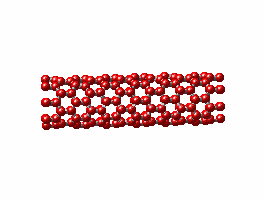ELIZABETH FIEND REPORTS: As an avid cyber punk fan I’ve been longing for William Gibson’s future, where I could step into a convenience store nano-dispenser and emerge clad in a swirling, gleaming, electronic nano-dress, one that changes motif with my every thought. A world where my social calendar, stored in a nano-rhinestone atop my sunglasses, would be filled with the wild parties of tomorrow. Today’s nanotechnology isn’t quite as sexy as that, but it’s just as unrestrained. Currently nanotechnology centers around the production of super-teeny-tiny materials and chemicals. We’re talking small, atomic scale small, the size of a molecule ? like a particle one thousandth the width of a human hair. Specifically, one nano-metre is equal to one billionth of a meter. As more and more particles are being manufactured with lengths between 1 and 100 nanometers, industry experts say these materials may pose unpredictable risks to the public. OK, I’m going to go out on a limb here and go on record right now: I predict that these super-small materials will pose unexpected problems.
could step into a convenience store nano-dispenser and emerge clad in a swirling, gleaming, electronic nano-dress, one that changes motif with my every thought. A world where my social calendar, stored in a nano-rhinestone atop my sunglasses, would be filled with the wild parties of tomorrow. Today’s nanotechnology isn’t quite as sexy as that, but it’s just as unrestrained. Currently nanotechnology centers around the production of super-teeny-tiny materials and chemicals. We’re talking small, atomic scale small, the size of a molecule ? like a particle one thousandth the width of a human hair. Specifically, one nano-metre is equal to one billionth of a meter. As more and more particles are being manufactured with lengths between 1 and 100 nanometers, industry experts say these materials may pose unpredictable risks to the public. OK, I’m going to go out on a limb here and go on record right now: I predict that these super-small materials will pose unexpected problems.
What’s so great about being so small? The whole point of nanomaterials is that by bunching together a mass of very teensy particles, you increase surface area — a lot. Take a moment to think about that. Nanotech is invading almost every industry — plastics, energy, medicine, electronics, food packaging, all the way up to the atmosphere via the aerospace industry. These novel material structures and their unique properties make stuff really strong and long lasting, they allow materials to absorb and radiate extremely specific wavelengths of light, and by being so small they have the ability to penetrate cellular barriers. They’re also extremely chemically active.
Any alarms going off in your head? If not, what if I told you they’re already here — in your medicine chest? Yeah, nanotechnology has invaded the personal care products industry. As you read, there are about 250 personal care products on the market stating they contain nano-materials like the Bionova Grand Slam skin care line. Or Flex-Power — rub some into your leg and get relief from your tired, aching calf muscle with its trademarked Flex-Somes, which they say are “comprised of microscopic capsules that penetrate quickly and deeply.” You may have already slathered some nanomaterials on yourself and never even knew that the great coverage you get from that sun block came from titanium dioxide in very tiny particles.
When you change the size of substances, what ever they are — metals, ceramics, alloys, they essentially become different materials with different structural characteristics and different behaviors. But what happens if common, safe elements react differently with our bodies when they’re super under-sized? I’ll tell you what. Actually I can’t tell you because their toxicity level is largely unknown. We do know that nanoparticles can cause pre-cancerous lesions, inflammation, and change brain cells. In June, an Environmental Protection Agency study found that titanium particles caused neurological changes in mice. Nano-sized particles of titanium dioxide, the kind used in your sunscreen, seem to be significantly more toxic than particles of standard size. Preliminary research has also found that nanoparticles can pass through body tissue more easily than the same material of a larger size. Great for intended targets like medical therapies, but this same quality has a giant potential for unintended negative consequences. Aside from sunscreen, another 9,500 personal care products list ingredients which are available in nano size but are not labeled as either nano size or conventional macroscale. There is no law requiring such labeling.
Are you getting a little worried yet?
Did I mention that nanoparticles are already present, unlabeled, in our shampoo? Yep that stuff you slather on and rub into your scalp several times every week for your whole life. I wonder how many nano-meters my scalp is from my brain? Largely, these nanomaterials have not been tested for safety by the Food and Drug Administration or the industry’s own Cosmetic Ingredient Review Expert Panel. In the U.S. we tend to regulate from the product, rather than the process, side of the industry. Uncle Sam may only look into this after environmental or health problems are evident.
Ha, ha you know what? Even if the FDA wanted to make tests on cosmetics mandatory, they’re not allowed to under federal law. Thank you, lobbyists. Back to that sun block. Maybe this stuff is safe for you and maybe someone will test how it effects human skin. But what about if after you apply the sun block you go swimming in a lake? What if some of that super sun block slips off your skin and dissolves in the water or drops to the bottom of the lake bed? What might those tiny titanium dioxide particles do to the little fishies? What could they do to the ground water, which will eventually become someone’s drinking water? Fact is, we have absolutely no idea, no idea at all and there is no government agency which is even going to look into this or require answers in advance
of production.
Occupational problems: Unfortunately, it gets much more complicated. Concerns are not only about the safety of using nano products ? to us, to wildlife or to the environment — they also stem from pre- and post-production processes. Think asbestos.The nanomaterials embedded in the resin of your new Babolat tennis racket may pose no risk to you. But what about the guy in the factory who made it? Or the workers in the company who will dispose of or recycle the racket after you get tennis elbow? What will happen if that racket is ground up and used to make filler for concrete?
Exposure to these smaller-than-dust-sized particles ? be it human or environmental exposure ? during production or disposal may be sizeable. What are the risks? Unknown. The industry has studied that, either. Nanomaterials are currently in use in many and varied household items, like Simmons Beauty Rest Mattress’s zip-off top, which wicks away sweat and as a special toxic bonus comes with Teflon fabric protection! In the near future, if not already on the market, expect nanotechnology applied to super-fast computer drives, construction materials, paints, food packaging with anti-fungal and anti-microbial surfaces, medical diagnostic tools and therapies like a special wrapper for burn victims. All these things could be great. But . . .
In America, the largest single investor in nanotechnology is our government. After that, development is being done within this country and abroad by many small unconnected companies developing their own products basically in secret. This decentralized invention will make it even harder to get a grasp on potential hazards.
What to do?
What we should do is label which products contain nanomaterials. Nonoparticles which will be released into the environment should be highly suspect, if not prohibited. We also need to do extensive risk analysis and update existing policies to address differences in the way nanoparticles should be regulated. It’s so complicated, new products should be assessed on a case-by-case basis — which will never happen. It’s possible we might even lose control of these nanomaterials. The father of nanotechnology, Eric Drexler, originally said nanotechnology’s worst nightmare would be runaway, self-replicating nanoparticles which could literally eat the Earth and turn the planet into grey goo. He’s recently backed off that scenario and said our worst fear will be nanotech weapons.
Ah, oh, military applications . . .
 ABOUT THE AUTHOR: Elizabeth Fiend is Philadelphia’s Beloved Revolutionary Sweetheart. Most people don’t know it yet, but that will change. Miss Fiend is host of the Big Tea Party. But enough of my yackin’, here’s Elizabeth with the 411 on her column: “Most people don’t think about the fact that science doesn’t determine our government’s regulations and recommendations for health and the environment, it’s sleazy politicking and backroom lobbying that makes the rules and I would like to bring this fact more to the forefront,” she says. “My philosophy is decidedly anti-big business/governmental lobbying but in line with the science of (my idol, ok crush) Dr. Walter Willett, Harvard University School of Public Health. There’s an edge to it, but it’s not goofy new age-y stuff with no basis in fact. And besides all that, I am the most fun of all the health advocates. I’m the only one who consistently wears pink and is brewing absinthe in her kitchen (excuse me, that’s illegal, infusing absinthe).” Word.
ABOUT THE AUTHOR: Elizabeth Fiend is Philadelphia’s Beloved Revolutionary Sweetheart. Most people don’t know it yet, but that will change. Miss Fiend is host of the Big Tea Party. But enough of my yackin’, here’s Elizabeth with the 411 on her column: “Most people don’t think about the fact that science doesn’t determine our government’s regulations and recommendations for health and the environment, it’s sleazy politicking and backroom lobbying that makes the rules and I would like to bring this fact more to the forefront,” she says. “My philosophy is decidedly anti-big business/governmental lobbying but in line with the science of (my idol, ok crush) Dr. Walter Willett, Harvard University School of Public Health. There’s an edge to it, but it’s not goofy new age-y stuff with no basis in fact. And besides all that, I am the most fun of all the health advocates. I’m the only one who consistently wears pink and is brewing absinthe in her kitchen (excuse me, that’s illegal, infusing absinthe).” Word.
